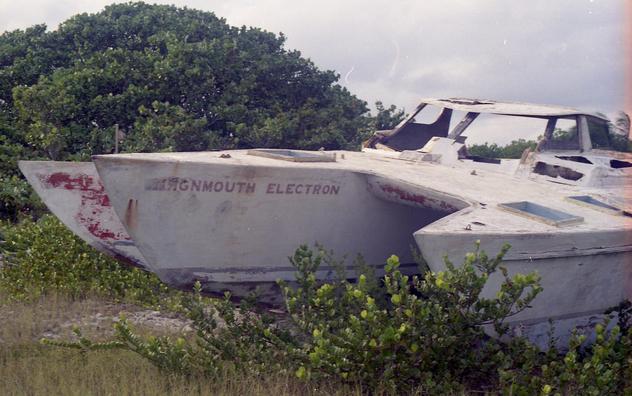 Movies and TV
Movies and TV  Movies and TV
Movies and TV  Weird Stuff
Weird Stuff 10 Times Real Laws Were Based on Bizarre Hypotheticals
 Animals
Animals 10 Inspiring Tales of Horses Being Human
 Mysteries
Mysteries Top 10 Haunting Facts About the Ghost Ship MV Alta
 History
History 10 Surprising Stories About the Texas Rangers
 Humans
Humans 10 Philosophers Who Were Driven Mad by Their Own Theories
 Miscellaneous
Miscellaneous 10 Video-Game-Worthy Weapons and Armors from History
 Weird Stuff
Weird Stuff 10 Psychics Who Accurately Predicted Wartime Events
 The Arts
The Arts 10 Pieces of Art Inspired by a Broken Heart
 Health
Health 10 Science Fiction-Sounding New Medical Treatments
 Movies and TV
Movies and TV 10 Movies That Get Elite Jobs Right, According to Experts
 Weird Stuff
Weird Stuff 10 Times Real Laws Were Based on Bizarre Hypotheticals
 Animals
Animals 10 Inspiring Tales of Horses Being Human
Who's Behind Listverse?

Jamie Frater
Head Editor
Jamie founded Listverse due to an insatiable desire to share fascinating, obscure, and bizarre facts. He has been a guest speaker on numerous national radio and television stations and is a five time published author.
More About Us Mysteries
Mysteries Top 10 Haunting Facts About the Ghost Ship MV Alta
 History
History 10 Surprising Stories About the Texas Rangers
 Humans
Humans 10 Philosophers Who Were Driven Mad by Their Own Theories
 Miscellaneous
Miscellaneous 10 Video-Game-Worthy Weapons and Armors from History
 Weird Stuff
Weird Stuff 10 Psychics Who Accurately Predicted Wartime Events
 The Arts
The Arts 10 Pieces of Art Inspired by a Broken Heart
 Health
Health 10 Science Fiction-Sounding New Medical Treatments
10 Real World Easter Eggs (Part 3)
Once again, it’s time for our periodic roundup of things that—were one to happen across them in an open-world video game—would be recognized immediately for what they are: easter eggs, put there by the programmers to mess with your head. Usually found in out-of-the-way or easily overlooked areas, these things generally seem to serve no purpose other than to say “Hey, congratulations, you found the weird thing. Weird, isn’t it?”
With no further ado, here are more in-jokes scattered throughout the real world, placed there by the cheeky, possibly disturbed programmers of the Universe.
10Salvador Dali Sundial

Surrealist master, Salvador Dali, was known to have a thing for timepieces. Most of us probably associate his name with bizarre landscapes, featuring floppy clocks draped over tree branches and the like. It’s no accident—the malleable nature of time is a recurring theme in his work, which is necessarily fraught with symbolism.
Residents of, or visitors to Paris, who happen to be art aficionados will find that this piece—hanging above a bagel shop as if it were the store’s sign—stands apart from the rest of the city’s sundials (there are a lot of them). It’s based on Dali’s print “Self-Portrait Sundial,” was designed by Dali himself, and was presented as a gift to the city in 1966. It’s more aesthetic than functional—it was designed not to tell time accurately, which, of course, we would expect from Dali.
The street above which the piece hangs, Rue Saint Jacques, was an ancient thoroughfare for pilgrims to Spain—which Dali claimed was represented symbolically through elements of this piece. We’re not going to disagree, but we’ll leave it to you to determine exactly how.
9The Surreal Elevator

In Long Island City, New York, there’s a plain, old office building that was once a Macy’s warehouse. Back then, the store catered to some pretty unique clientele—one that apparently had a strong appreciation for surreal, avant-garde artwork, which used to adorn the lobby and hallways, and an example of which is still hidden in quite an unexpected place.
This freight elevator appears to be just like any other, until the plain white doors open onto a swirling, garish wonderland of trippy colors and little mechanical creatures poking their heads through holes in the facade. While the rest of the building was long ago redecorated to a slightly more conventional mode of decor, this startling remnant of the building’s past has remained in place for decades, as an homage to this bygone era.
Potential seekers of office space in this otherwise unassuming building could be forgiven for thinking they’ve wandered into a Charlie Kaufman screenplay. One other remaining installation, in a basement lobby, appears to be a forever-melting schoolbus; as bizarre and out-of-place as it also is, we imagine it doesn’t sneak up on you quite like the elevator.
8The Garbage Goat Of Spokane

Spokane, Washington is a city that prides itself on environmental consciousness. Perhaps the oddest manifestation of this attitude can be found in Riverfront Park, which played host to the city’s Environmental Expo 1974. Strangely more functional than aesthetic—and once an unlikely source of controversy—this huge, metal, mechanical goat was designed and built by Sister Paula Turnbull specifically for the expo, as a means to do what real goats are famous for: dispose of trash. Upon approaching the sculpture, a recorded voice would request trash; at the push of a button, a powerful vacuum would suck the garbage right into the goat’s mouth. Cute, right? How could such a thing possibly cause controversy?
Well, it seems that local dairy farmers didn’t appreciate the propagation of goats’ image as walking trash compactors. They complained that their prize-winning (real) goats were being fed trash by visitors, and mounted a campaign to inform the public of goats’ “fastidious eating habits.” Despite the fact that the garbage goat’s corner of the park was the cleanest of them all, expo organizers temporarily shut down the robo-goat at the height of the controversy. Today, the goat is a selling point in Spokane’s bid to attract Google; in a video pitch, footage of it appears as the narrator intones, “Spokane has a long history of deploying technological advances that contribute to our community’s well-being.” Good luck, Spokane.
7The Swing Of Eternity

Hike up the mountain a few hours from the city of Banos, Ecuador, and you’ll find what appears to be a simple tree house with a crude swing, fashioned from two long ropes and a board. Appearances are deceiving: The tree house is actually a seismic monitoring station, and its position is strategic to Mt. Tungurahua, a periodically active volcano.
As for the swing, it’s no ordinary one. For those who have a thing about heights, it is the ultimate test of nerve. You can’t strap into this swing, and if you were to bail out, there’s no net to catch your fall—thousands and thousands of feet down the face of a sheer cliff. The locals call it “The Swing At The End Of The World.”
It’s a popular tourist attraction, with travelers of all ages taking their stomach-churning turn on the flimsy-looking board, sailing out over the abyss, while presumably grinding their teeth into powder and holding on for dear life. While no deaths have been reported, and the view does look truly spectacular, we think we would be content to watch others enjoy the ride, sweat from our palms pooling around our feet. Ropes can break.
6The Alien Postal Drop

If the state of Nevada—home of the infamous Area 51—has any desire to distance itself from its reputation as a hot spot of alien activity, it has funny ways of showing it. State Route 375, to the east of the famous military installation, has for so long been renowned for E.T. sightings and other strange occurrences that the state gave up, and officially named it “Extraterrestrial Highway” in 1996.
Situated in the middle of a long, barren stretch of this highway is the “Black Mailbox,” so named by locals despite the fact that it is white. Originally a public mailbox for workers at an old tungsten quarry, the box gained attention for its mysterious nature, and for being literally the only landmark on the entire 65-kilometer (40 mi) stretch between the towns of Alamo and Rachel. Famous maybe-Area 51-worker, Robert Lazar, claimed to have worked on alien spacecraft at nearby Nellis Air Force Base in the late ’80s. As a result, tourists began converging on Rachel (which prompted the renaming of “Rachel Bar and Grill” to “The Little A’Le’Inn”) to get smashed, before making their pilgrimages to the Black Mailbox. Here, it was said one could catch glimpses of UFOs on Tuesday (or maybe Wednesday) nights, presumably making post deliveries.
Owner Steve Medlin egged the tourists on by padlocking the box and painting “ALIEN DROP BOX” on its side; E.T. enthusiasts from as far away as Japan gather to debate what wares the aliens could have a need to absolutely, positively get delivered to the middle of nowhere by noon on Wednesday.
5The Church In The Basement

When Pat and Diane Farley and their son, Gareth, moved into their new home in Shropshire, UK, they might have expected to find that it had a few eccentricities. The house, after all, dated back to at least the mid-1700s, and was bound to have colorful stretches in its long history. What the Farleys didn’t know was that, at some point, their home had apparently functioned as a clandestine Catholic church. They might never have found out, if not for a bit of drunken poking around by their son and his uncle.
Outside the couple’s bathroom was what appeared to be a heating grid, but beneath it was a hole leading to a hidden cellar. When Gareth squeezed through, he got his first clue as to the history of their new digs, in the form of a giant, rotting wooden cross in the middle of the cellar floor. Crude brick benches were arranged like pews around the space, testifying (no pun intended) to its history as a hidden place of worship; and yet, it gets creepier.
Molding old trunks of books and newspapers from the early 20th century were also found undisturbed. And then there were the hooks—hanging from the ceiling, as though this house of the lord had at one point (perhaps even the same point) also functioned as a slaughterhouse. No word as to whether the Farleys decided to renovate the space into a snazzy rec room, or are perhaps charging neighboring children for tours around Halloween (which is absolutely what we would do).
4Wreck Of The Ghost Boat

In the late ’60s, Englishman Donald Crowhurst was having trouble with his business, an electronics company specializing in the sale of marine navigational equipment. A sailing enthusiast himself, Crowhurst decided that the best way to pump up business was to demonstrate the effectiveness of his equipment—by entering the Sunday Times Golden Globe Race, in a grueling attempt to circumnavigate the globe solo.
Using his house as collateral, Crowhurst purchased a 12-meter (40 ft) sailboat, the Teignmouth Electron. Unfortunately, he was unable to get all of his equipment installed before the race’s deadline; even more unfortunately, Crowhurst had obtained financial backing for his endeavor from a local millionaire—a rather large sum that he would have had to pay back if he failed to complete the race.
Inadequately prepared though he was, Crowhurst set sail. He soon realized that he had left important equipment at home—important enough that he knew he couldn’t make portions of his journey. After transmitting false positions for a while, then eventually breaking contact for 111 days, his family’s worst fears were confirmed when the Teignmouth Electron was found floating in the Atlantic, with no Crowhurst aboard. His last log entry read “There is no reason for harmful . . . ” and ended abruptly; no trace of him was ever found. The ship beached itself on Cayman Brac in the Caribbean Islands, and has remained there ever since.
3The Forevertron
A few klicks south of Baraboo, Wisconsin, off a lonely patch of State Highway 12, is an unlikely spot for a Forevertron. What is a Forevertron, you ask? Well, it’s . . . you tell us. Look at it. Is it a theme park? A museum? An actual spaceship? According to its creator, it is any and all of these things. Then again, one may want to take with a grain of salt the words of a grown man who calls himself “Dr. Evermor.”
The alter-ego of Tom Every, a veteran of the industrial wrecking industry, Dr. Evermor began constructing this monolithic monument to . . . something in 1983. The current structure weighs over 300 tons, is over 15 meters (50 ft) high, and contains lots and lots of remnants from different phases of the industrial age. Neon signs, theater speakers, even a pair of dynamos constructed by Thomas Edison live alongside spiral staircases and ornate walkways. Practically any kind of industrial equipment from the last century can be found contributing to the overall aesthetic of the Doctor’s design, which he never committed to any blueprint—he just builds, builds and then builds some more.
Perhaps the most unlikely addition to the sculpture? Parts of the decontamination chamber from the Apollo moon mission, including autoclaves once used to treat actual moon rocks. Perhaps these will come in handy if the Forevertron is ever able to actually achieve liftoff—we can’t say it would surprise us.
2The Country Singer’s Memorial

Fans of country music experienced their very own “Day The Music Died” on March 5, 1963, when a private plane went down outside Camden, Tennessee. The plane had been transporting rising stars Cowboy Copas, Hawkshaw Hawkins, and the legendary Patsy Cline. Only 30 at the time of her death, Cline had only a year earlier notched one of country music’s most indelible hits with her cover of Willie Nelson’s ballad “Crazy.”
At the bottom of a hill near the crash site, where one of the plane’s engines dug itself into the earth, is a plaque memorializing the four (including pilot Randy Hughes) who lost their lives. Situated, as it is, in the middle of a forest, many hikers in the area were likely quite surprised to stumble across this handsome memorial to one of country’s most iconic stars; until very recently, no paths or markers existed to guide anyone to the site.
In 2011, local government installed a small walkway to make the site easier to access, and there are plans for a more elaborate memorial—beginning with the sale of commemorative bricks, the proceeds of which may go to fund a performing arts center. Until then, this plaque—celebrating the life of one of the 20th century’s more iconic vocalists—will continue to largely be appreciated only by those who know of it and seek it out, or those who stumble across it completely by accident.
1The Center Of The World

Finally, we all know where the center of the Universe is, but what about the center of our lonely world? Well, that one has an answer, too: Braceville township, Ohio. According to that sign, the center of the world is in Ohio.
The story goes that a rich Pennsylvanian businessman, Randell Wilmot, rolled into town in the 1840s and built a complex that included a general store, saloon, and stagecoach station. Since the area wasn’t exactly bustling, he slapped the title “Center of the World” onto his new development, hoping to attract traffic fitting of such a name. It didn’t work.
When the development failed to prosper, Mr. Wilmot moved his operation east, to the city of Cortland, renaming it “The End of the World.” (Despite being from Pennsylvania, Wilmot apparently thought that the state of Ohio comprised the entire world.) Appropriately, he soon died there. Though the Braceville township sign has been stolen several times, officials keep replacing it—if they didn’t, we might all completely lose our bearings.








